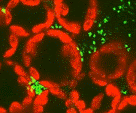Plant Pathology, Department of

Department of Plant Pathology: Faculty Publications
Document Type
Article
Date of this Version
2017
Citation
Chapter in 2017 Crop Production Clinic Proceedings, University of Nebraska-Lincoln Extension, Institute of Agriculture and Natural Resources, pp. 185–188.
Abstract
Fungicide resistance has developed in some diseases of row crops as well as specialty crops. This implies that fungicide applications to control such diseases may no longer be effective. Scientific studies have shown that fungicide resistance develops through natural selection of a mutant strain of a pathogen in a population that is resistant to fungicides. Resistance is very difficult to eliminate but can be delayed through appropriate management practices. The availability of inexpensive options with single mode of action products being available makes this an important issue so we do not repeat what was done in weed management.
Introduction
Frogeye Leaf Spot of Soybean
General Management of Frogeye Leaf Spot … Resistance … Cultural Practice … Fungicide Application
Gray Leaf Spot of Corn
Management of Gray Leaf Spot … Hybrid resistance … Cultural practices … Fungicides … Integrated management
Fusarium Head Blight of Wheat
Management of FHB … Cultivar Selection ... Cultural practices … Fungicides … Biological control … Integrated Management
Asochyta Blight of Chickpea
Management of Asochyta Blight … Resistance … Cultural … Chemical
Risk Factors for Development of Fungicide Resistance
Management Recommendations
Additional Resources


Comments
Copyright © 2017 The Board of Regents of the University of Nebraska.